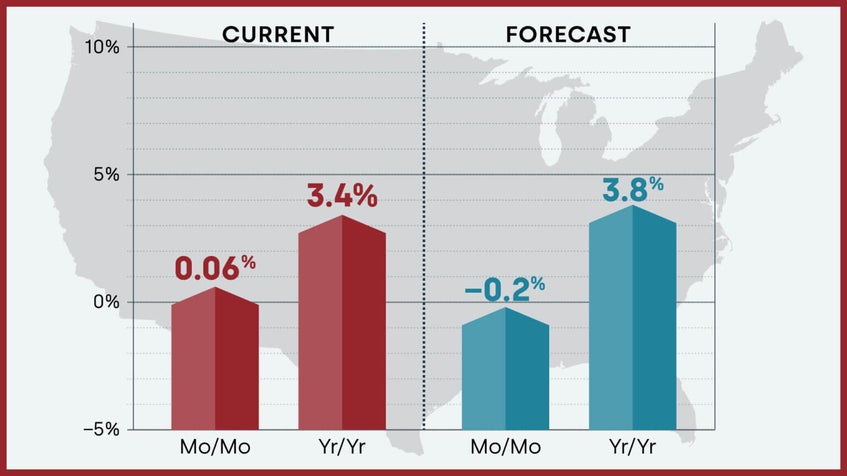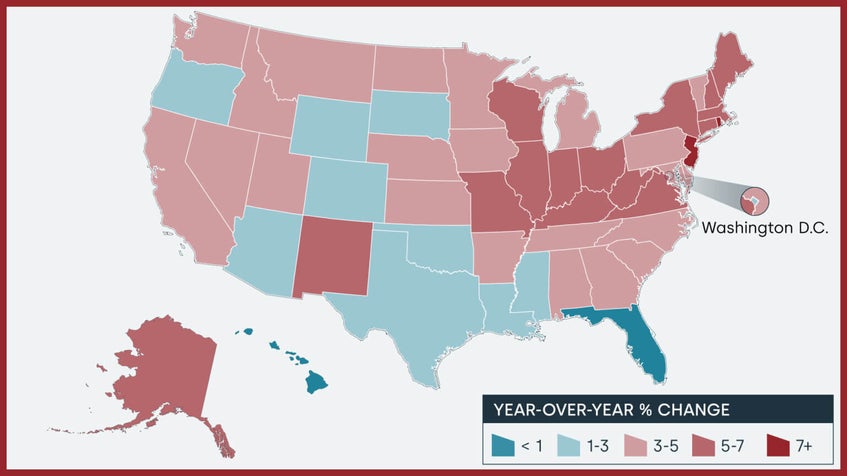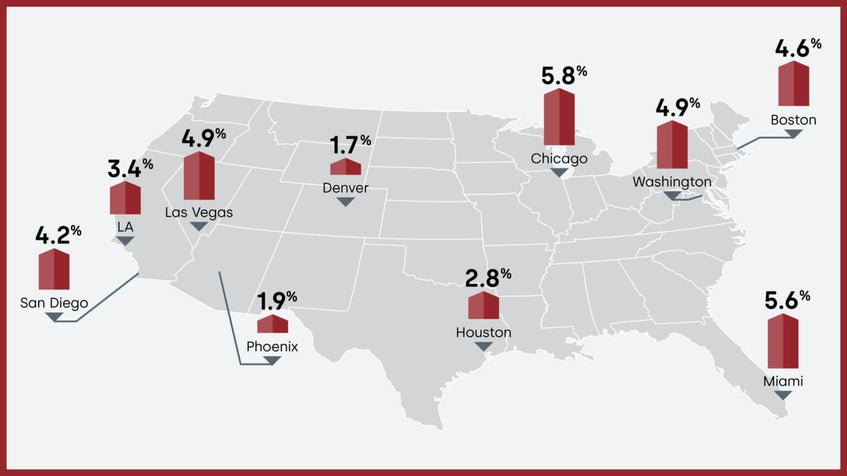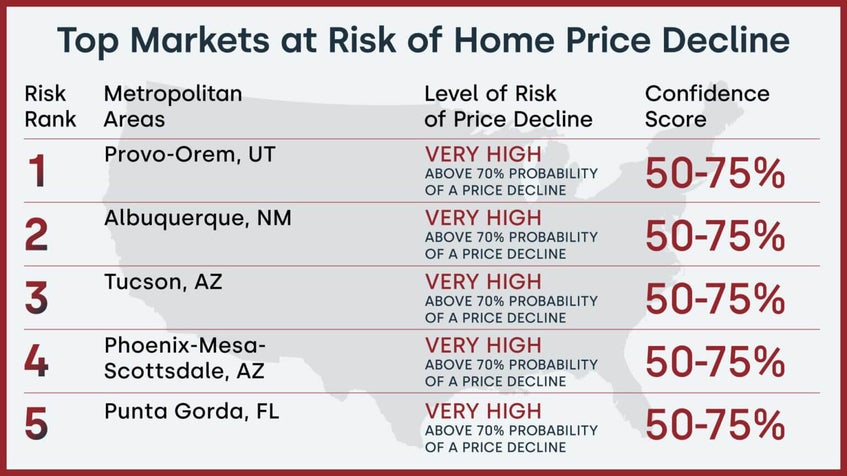Home prices nationwide, including distressed sales, increased year over year by 3.4% in November 2024 compared with November 2023. On a month-over-month basis, home prices increased by 0.06% in November 2024 compared with October 2024 (revisions with public records data are standard, and to ensure accuracy, Cotality incorporates the newly released public data to provide updated results).
Forecast prices nationally
The Cotality HPI Forecast indicates that home prices will drop by -0.2% from November 2024 to December 2024 and increase by 3.8% on a year-over-year basis from November 2024 to November 2025.
Northeast remained hot even as homebuying season cooled off for 2024
While the Northeast dominated November U.S. home price growth trends, the three core based statistical areas (CBSAs) with the most significant growth were primarily in Appalachia. The Wheeling, WV and Ohio area; Johnstown, PA; and the Huntington-Ashland metropolitan area that spans seven counties in Kentucky, Ohio and West Virginia all saw year-over-year price growth jumps, increasing by 20%, 16%, and 14.8%, respectively. Unsurprisingly, this substantial CBSA-level growth spurred prices in West Virginia to reach new records in November 2024.
Looking farther west in the U.S., states continue to lag their previous peaks, Wyoming, Idaho, Washington and Hawaii saw prices remain the furthest from their peaks in November, with declines ranging from -3.5% to –2%.
Despite pockets of decline, national prices are continuing to trend upward, even in the off-season. The November median sales price for all single-family homes in the U.S. was $395,000, up $10,000 from the previous month. Come spring, it is likely that the national housing market will be reinvigorated and push prices even higher.
HPI national and state maps – November 2024
Nationally, home prices increased by 3.4% year over year in November. No state posted an annual home price decline. The states with the highest increases year over year were New Jersey (up by 7.8%) and Rhode Island (up by 7.3%).
HPI top 10 metros change
The Cotality HPI provides measures for multiple market segments, referred to as tiers, based on property type, price, time between sales, loan type (conforming vs. non-conforming) and distressed sales. Broad national coverage is available from the national level down to ZIP Code, including non-disclosure states. Below is a look at home price changes in 10 select large U.S. metros in November, with Chicago posting the highest gain at 5.8% year over year.
Markets to watch: top markets at risk of home price decline
The Cotality Market Risk Indicator (MRI), a monthly update of the overall health of housing markets across the country, predicts that Provo-Orem, UT (70%-plus probability) is at a very high risk of a decline in home prices over the next 12 months. Albuquerque, NM; Tucson, AZ; Phoenix-Mesa-Scottsdale, AZ; and Punta Gorda, FL; (70%-plus probability) are also at very high risk of declines in home prices over the next 12 months.
Summary
Cotality HPI features deep, broad coverage, including on-disclosure state data. The index is built from industry-leading real-estate public record, servicing, and securities databases—including more than 40 years of repeat-sales transaction data—and all undergo strict pre-boarding assessment and normalization processes.
Cotality HPI and HPI Forecasts both provide multi-tier market evaluations based on price, time between sales, property type, loan type(conforming vs. non-conforming) and distressed sales, helping clients hone in on price movements in specific market segments.
Updated monthly, the index is the fastest home-price valuation information in the industry—complete home-price index datasets five weeks after month’s end. The Index is completely refreshed each month—all pricing history from 1976 to the current month—to provide the most up-to-date, accurate indication of home-price movements available.
Methodology
The Cotality HPI™ is built on industry-leading public record, servicing and securities real-estate databases and incorporates more than 40 years of repeat-sales transactions for analyzing home price trends. Generally released on the first Tuesday of each month with an average five-week lag, the Cotality HPI is designed to provide an early indication of home price trends by market segment and for the “Single-Family Combined” tier, representing the most comprehensive set of properties, including all sales for single-family attached and single-family detached properties. The indices are fully revised with each release and employ techniques to signal turning points sooner. The Cotality HPI provides measures for multiple market segments, referred to as tiers, based on property type, price, time between sales, loan type (conforming vs. non-conforming) and distressed sales. Broad national coverage is available from the national level down to ZIP Code, including non-disclosure states.
Cotality HPI Forecasts™ are based on a two-stage, error-correction econometric model that combines the equilibrium home price—as a function of real disposable income per capita—with short-run fluctuations caused by market momentum, mean-reversion, and exogenous economic shocks like changes in the unemployment rate. With a 30-year forecast horizon, Cotality HPI Forecasts project Cotality HPI levels for two tiers — “Single-Family Combined” (both attached and detached) and “Single-Family Combined Excluding Distressed Sales. ”As a companion to the Cotality HPI Forecasts, Stress-Testing Scenarios align with Comprehensive Capital Analysis and Review (CCAR) national scenarios to project five years of home prices under baseline, adverse and severely adverse scenarios at state, metropolitan areas and ZIP Code levels. The forecast accuracy represents a 95% statistical confidence interval with a +/- 2% marginof error for the index.
About Market Risk Indicator
Market Risk Indicators are a subscription-based analytics solution that provide monthly updates on the overall “health” of housing markets across the country. Cotality data scientists combine world-class analytics with detailed economic and housing data to help determine the likelihood of a housing bubble burst in 392 major metros and all 50 states. Market Risk Indicators is a multi-phase regression model that provides a probability score (from 1 to 100) on the likelihood of two scenarios per metro :a >10% price reduction and a ≤ 10% price reduction. The higher the score, the higher the risk of a price reduction.
Source: Cotality
The data provided are for use only by the primary recipient or the primary recipient’s publication or broadcast. This data may not be resold, republished or licensed to any other source, including publications and sources owned by the primary recipient’s parent company without prior written permission from Cotality. Any Cotality data used for publication or broadcast, in whole or in part, must be sourced as coming from Cotality, a data and analytics company. For use with broadcast or web content, the citation must directly accompany first reference of the data. If the data are illustrated with maps, charts, graphs or other visual elements, the Cotality logo must be included on screen or website.
















